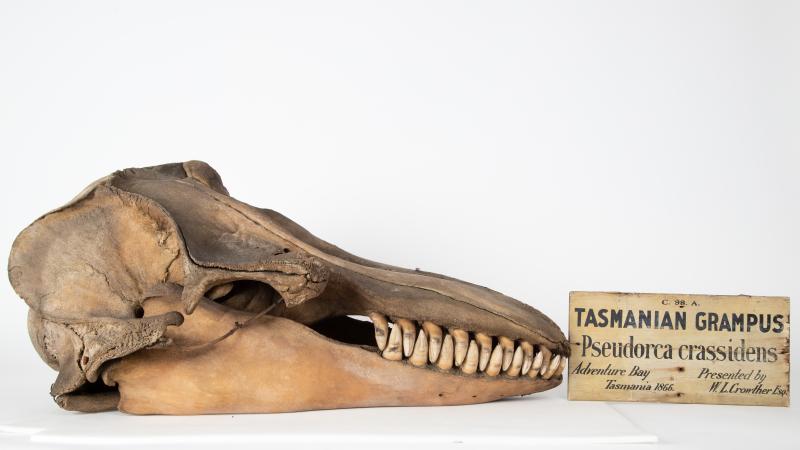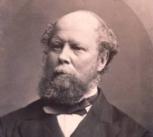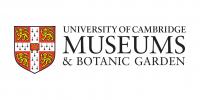What’s in the collection?
The skeleton of a false killer whale (UMZC C.98.A and UMZC C.98C).

When did it arrive?
1866
What do we know about the specimens in Cambridge?
The whale was part of a mass stranding event in Adventure Bay, Tasmania, in 1866. It was sent by Crowther to John Willis Clark at the Museum. Another false killer whale, from the same stranding and also donated by Crowther, is hanging in the entrance hall to the Tasmanian Museum and Art Gallery in Hobart, who also hold other Crowther whale specimens.
In his youth, Crowther amassed a large collection of around 500 animal skins, as well as a collection of live animals, which he sold to the Earl of Derby in 1832.
Who was William Crowther?

Crowther, was born to English parents in the Netherlands in 1817, and moved with his family to Hobart in 1825. He undertook medical training in London from 1839 to 1842, when he returned to Tasmania. As well as engaging in pelagic whaling operations, in 1860 he became honorary medical officer at Hobart General Hospital.
Please be aware that the below includes details of racist attitudes and the mistreatment of First Nations Australian people’s remains.
Crowther was involved in the acquisition and trade of Indigenous remains, most famously through his mutilation of the body of William Lanne in 1869. At the time, Lanne was considered by settler colonists to be the “last male Aboriginal Tasmanian”, and Crowther was desperate to acquire his skeleton on behalf of England’s Royal College of Surgeons (who awarded Crowther their gold medal). However, Morton Allport (another of our Museum’s donors) claimed the body for the Royal Society of Tasmania (RST) at the same time, causing disagreement about which institution should receive Lanne’s remains.
The Colonial Secretary, Richard Dry determined that Lanne’s eventual destination would be the RST, but that he would receive a proper burial first, and sometime later his skeleton would be retrieved for the Society. When Crowther learned of this decision, he angrily told the messenger they were “a fool to suppose that a paltry little place like Tasmania had a better right to it than London”.1 This exemplifies the colonial attitude that “science” was best done in the colonial metropole rather than within the colony itself.
Crowther then took matters into his own hands, and before Lanne was buried, broke into the hospital and stole his skull from his body, replacing it with the skull of a dead white man who also lay in the mortuary. This is how Lanne was buried, and Crowther then returned to the grave to steal his skeleton too. However, he arrived too late. Most likely acting under instruction from Allport, almost immediately after his funeral, Lanne had already been disinterred and his skeleton taken before Crowther got there – it later appeared in the Royal Society of Tasmania’s collection. Crowther never returned Lanne’s skull.
The public reaction to the disrespectful treatment of two bodies was significant, and Crowther was charged with Lanne’s mutilation and was stripped of his position at the hospital. Despite this, just weeks later he was elected to the Tasmanian Legislative Council – a seat he held till his death – and he served as Premier of Tasmania from 1878 to 1879. A statue of him was erected in Hobart’s Franklin Square by public subscription. In 2022, after a major public consultation and series of artistic interventions, Hobart City Council voted to remove the statue following years of campaigning from Aboriginal groups.
Further reading:
Ashby, J. (in press, 2023). How collections and reputation were built out of Tasmanian violence: thylacines and Aboriginal remains from Morton Allport. Archives of Natural History 50(2).
References
1. The Commission of Enquiry, 1869 Mutilation of the body of the last male Aboriginal. Launceston Examiner, 16 March, p.3.





